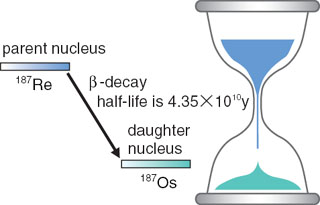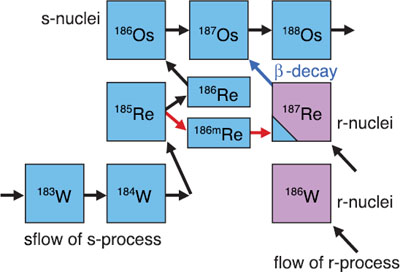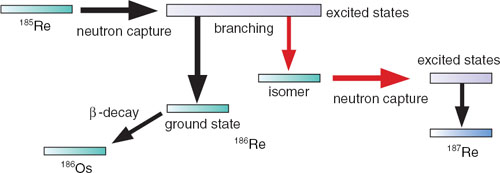4-3 | Development of a 187Re-187Os Nucleo-Cosmochronometer by Using Neutrons from Nuclear Reactors |

|
||
|

|
||
|
 |
||
|
| Nucleo-cosmochronometers are useful tools to evaluate the elapsed time from a nucleosynthesis event to the present time by measurement of the abundance ratio of parent and daughter nuclei (Fig. 4-6). These chronometers are applied to age estimation of stars by astronomical observations and the study of the solar system formation by analyses of meteorites. The determination of the astrophysical origin of the nuclei of the chronometers is important for these application. A nucleus 187Re is synthesized by a neutron-capture reaction-chain that is considered to occur in supernova explosions (r-process). The 187Re-187Os system is known to be the chronometer for the r-process. We find that 187Re may be synthesized by a new s-process path via an isomer of 186Re as shown in Fig. 4-7. The s-process is considered to occur in asymptotic giant branch stars. Since the neutron-capture cross-sections with experimental uncertainty to the isomer has not been reported, the synthesis via the isomer has been ignored (Fig. 4-8). We measured the neutron-capture cross-section ratio of the isomer to the ground state at JRR-3 and JRR-4. The Re samples were irradiated by thermal neutrons for 24 hours. After the cooling time of ca. 4 months, we measured the decay of the samples and evaluated the neutron-capture cross-section ratio with its uncertainty for the first time. The ratio is 0.54 ± 0.11%. The upper limit of the difference of the age estimation using the chronometer with and without this isomer effect is 2%. |
| Reference T. Hayakawa et al., New s-Process Path and Its Implications for a 187Re-187Os Nucleo-Cosmochronometer, Astrophys. J., 628, 533 (2005). |
| Select a topic in left column | |
| Persistent Quest Research Activities 2005 Copyright (C) Japan Atomic Energy Research Institute |